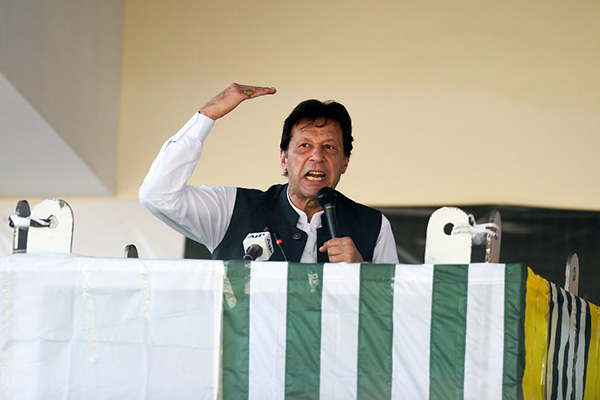
File photo of P.M. Imran Khan. Aamir Qureshi—AFP
China’s distancing from India is not quite the slam dunk Pakistan might like it to be
U.S. President Trump has exited the 1987 Missile Technology Control Regime, under which 35 countries had agreed to restrict the sales of unmanned weapons delivery systems, and has started supplying India with drones that deliver the banned “large payload.” This means an escalation of the mutual threat between Pakistan and India with the latter—as a matter of policy—refusing to “normalize” with Pakistan. The strengthening of India’s policy of internal “cleansing” and external policy of pressure on its neighbors—Nepal, Bangladesh, Pakistan—has thus received American approval despite the bad press abroad.
India has benefited from Trump’s China policy, which unfortunately doesn’t put off his “allies” in Europe and hugely buttresses India’s policy of taking on Beijing and its superpower strength in the region. China has its Belt and Road projects going well enough abroad to scare the region’s strongman, India: its infrastructure projects are doing well in Bangladesh, Sri Lanka and Pakistan. Because of a lack of funds, Sri Lanka has handed over one of its ports to China; and the world expects that Islamabad would do the same with the Gwadar port, which is the linchpin of the grand economic transformation of Pakistan.
China has its traditional “agreed” projects in Afghanistan and is waiting for better conditions after America’s exit from there to connect Afghanistan’s economy to the China-Pakistan Economic Corridor (CPEC). India, with a big economic presence in the Arab Gulf, was following a “balancing” policy with Iran, as highlighted by its construction of the Chabahar Port in a kind of consolidation of India’s presence in Afghanistan.
Before President Trump showed interest in getting together with India against China, Delhi was unmindful of the umbrage it gave—through its Iran policy—to the Arabs in the Gulf fighting at least three wars covertly supported by Iran in what is seen as the 21st century’s sectarian Armageddon of Islam. Saudi Arabia and the U.A.E., investing heavily in India to offset the losses expected to occur from the depletion of their oil, were still in the process of rethinking their India policy, when Delhi decided to bow out of Tehran.
Iran, verbalizing their anger at India’s sudden about-face on the Chabahar project reached out to China, which was already involved in a big way in Iran’s infrastructure, and signed a $244 billion deal with Beijing, thus further confirming Chinese trade presence in the region, including in the Gulf. India is now all set to assert itself as America’s ally—or substitute?—in the Middle East, counting on Israel as an important ally. Looking eastward, India is prepared to join America’s other allies—Japan, South Korea, Australia—to oppose China’s domination of the South China Sea. India would strengthen its naval presence in the Indian Ocean, which would directly threaten an economically weakened Pakistan.
China’s regional policy has to be considered irresistible if you look how it has bailed out various states in the region. Turkey President Recep Tayyip Erdogan’s ill-considered attacks on Chinese domestic policy—directly hitting out at its treatment of Uighurs of Turkish descent—disappeared after China’s Central Bank offered $1 billion bailout to stabilize Turkey’s economic deficit; Saudi Arabia was fed with “development” through China-assisted “Vision 2030” after President Trump started talking of leaving the region. And of course Pakistan is already on the bandwagon.
Pakistan is in deep internal trouble, mostly political, which is bound to ultimately hurt its economy that is already in the oxygen-tent of the IMF. It has vicariously felt “strengthened” by the India-China military clash in Ladakh but should worry about its political and economic capacity to successfully complete the Belt and Road grand project on its soil. Poor in manpower quality and high on Islamic ideology, it may face more internal unrest than the one caused by India’s externally administered punishment for Pakistan’s own earlier misadventures inside India. Despite its long friendship with China, Pakistan hardly apologizes for not giving credence to China’s pragmatism in its relations with India—it is India’s largest trading partner—and may become a hurdle in the way of China’s real strategy in South Asia.
Pakistan’s own malady of extremism has struck its rival India too and may therefore make “normalization” impossible in the region. In Pakistan, the “arranged” dominance of the ruling party Pakistan Tehreek-e-Insaf (PTI) has seen a total prostration of the main opposition Pakistan Peoples Party (PPP) and Pakistan Muslim League-Nawaz (PMLN) and there is no prospect of political change for the better. Anti-U.S. and Islamist, Prime Minister Imran Khan knows that there will be no credible alternative to him for some time to come. In India, too, people who are unhappy with the Hindutva ideology of Bharatiya Janata Party (BJP) despise the opposition Congress even more. The door to natural change is closed with Prime Minister Modi sitting on top of a booming economy with $480 billion as foreign exchange reserves while a bankrupt Imran Khan struggles to reform the state away from aiding and abetting terrorism, under Financial Action Task Force (FATF) “corrections.”
Pakistan’s further “Islamization” of education currently underway would not help the present situation. The system of education has acted as a brainwashing tool for several decades and would take radical realism of many additional decades to enable it face up to the challenges it now has to deal with. It has to deal realistically with revengeful next door neighbor India and balance its conduct of foreign policy in the Gulf, normalizing with Iran without offending the Arabs. It has to reconcile its intensification of Islamic ideology with its foreign policy, which will simply mean controlling the sectarian clergy and preventing it from spreading a suicidal extremism that has hounded Pakistan for decades. For the rest, leave it to the nations doing better economically and try to adjust to their actions through internal normalization.
